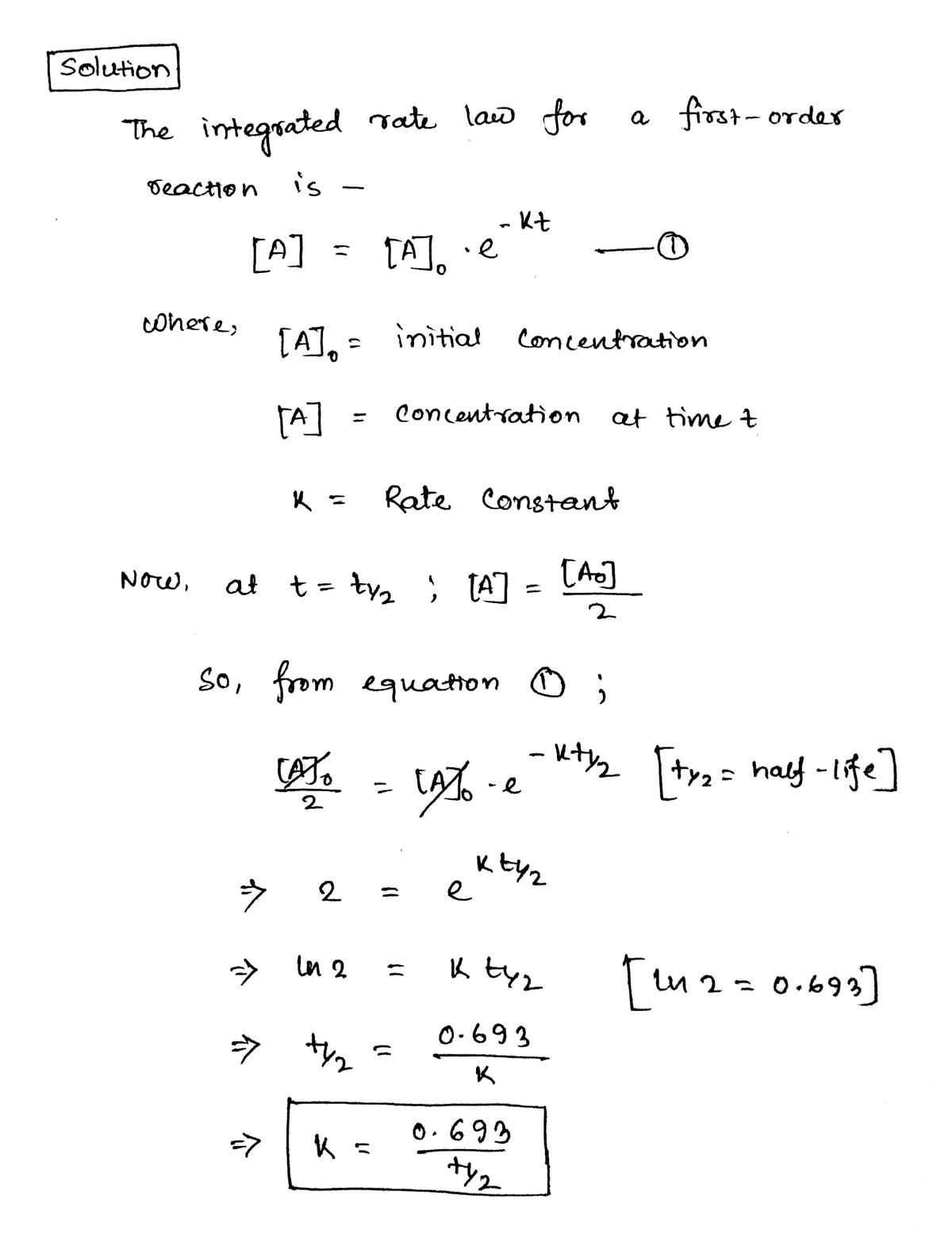The integrated rate law allows chemists to predict the reactant concentration after a certain amount of time, or the time it would take for a certain concentration to be reached. The integrated rate law for a first-order reaction is: What the rate constant of a first-order reaction that takes 307 seconds for the reactant concentration to drop to half of its initial value? Express your answer with the appropriate units. [A] = [A]ge kt > View Available Hint(s) Now say we are particularly interested in the time it would take for the concentration to become one-half of its initial value. Then we could substitute for [A and ? rearrange the equation to: Value Units 0.693 This equation calculates the time required for the reactant concentration to drop to half its initial value, In other words, it calculates the half-life. Submit
The integrated rate law allows chemists to predict the reactant concentration after a certain amount of time, or the time it would take for a certain concentration to be reached. The integrated rate law for a first-order reaction is: What the rate constant of a first-order reaction that takes 307 seconds for the reactant concentration to drop to half of its initial value? Express your answer with the appropriate units. [A] = [A]ge kt > View Available Hint(s) Now say we are particularly interested in the time it would take for the concentration to become one-half of its initial value. Then we could substitute for [A and ? rearrange the equation to: Value Units 0.693 This equation calculates the time required for the reactant concentration to drop to half its initial value, In other words, it calculates the half-life. Submit
Chemistry: The Molecular Science
5th Edition
ISBN:9781285199047
Author:John W. Moore, Conrad L. Stanitski
Publisher:John W. Moore, Conrad L. Stanitski
Chapter11: Chemical Kinetics: Rates Of Reactions
Section: Chapter Questions
Problem 11.ACP: (Section 11-5) A rule of thumb is that for a typical reaction, if concentrations are unchanged, a...
Related questions
Question
![Part B
The integrated rate law allows chemists to predict the
reactant concentration after a certain amount of time, or
the time it would take for a certain concentration to be
reached.
What is the rate constant of a first-order reaction that takes 307 seconds for the reactant concentration to drop to half of its initial value?
The integrated rate law for a first-order reaction is:
Express your answer with the appropriate units.
[A] = [A]oe kt
• View Available Hint(s)
Now say we are particularly interested in the time it would
take for the concentration to become one-half of its initial
[A],
for [A] and
?
value. Then we could substitute
2
rearrange the equation to:
Value
Units
0.693
t1/2 =
k
This equation calculates the time required for the
reactant concentration to drop to half its initial value. In
other words, it calculates the half-life.
Submit](/v2/_next/image?url=https%3A%2F%2Fcontent.bartleby.com%2Fqna-images%2Fquestion%2F87faf35d-bdff-4fde-b9fe-6459d170f061%2F1d52465a-7fd3-41ee-beb5-afd59ad7eccc%2F1qkzmha_processed.jpeg&w=3840&q=75)
Transcribed Image Text:Part B
The integrated rate law allows chemists to predict the
reactant concentration after a certain amount of time, or
the time it would take for a certain concentration to be
reached.
What is the rate constant of a first-order reaction that takes 307 seconds for the reactant concentration to drop to half of its initial value?
The integrated rate law for a first-order reaction is:
Express your answer with the appropriate units.
[A] = [A]oe kt
• View Available Hint(s)
Now say we are particularly interested in the time it would
take for the concentration to become one-half of its initial
[A],
for [A] and
?
value. Then we could substitute
2
rearrange the equation to:
Value
Units
0.693
t1/2 =
k
This equation calculates the time required for the
reactant concentration to drop to half its initial value. In
other words, it calculates the half-life.
Submit
Expert Solution
Step 1

Step by step
Solved in 2 steps with 2 images

Knowledge Booster
Learn more about
Need a deep-dive on the concept behind this application? Look no further. Learn more about this topic, chemistry and related others by exploring similar questions and additional content below.Recommended textbooks for you

Chemistry: The Molecular Science
Chemistry
ISBN:
9781285199047
Author:
John W. Moore, Conrad L. Stanitski
Publisher:
Cengage Learning

General Chemistry - Standalone book (MindTap Cour…
Chemistry
ISBN:
9781305580343
Author:
Steven D. Gammon, Ebbing, Darrell Ebbing, Steven D., Darrell; Gammon, Darrell Ebbing; Steven D. Gammon, Darrell D.; Gammon, Ebbing; Steven D. Gammon; Darrell
Publisher:
Cengage Learning

Chemistry & Chemical Reactivity
Chemistry
ISBN:
9781133949640
Author:
John C. Kotz, Paul M. Treichel, John Townsend, David Treichel
Publisher:
Cengage Learning

Chemistry: The Molecular Science
Chemistry
ISBN:
9781285199047
Author:
John W. Moore, Conrad L. Stanitski
Publisher:
Cengage Learning

General Chemistry - Standalone book (MindTap Cour…
Chemistry
ISBN:
9781305580343
Author:
Steven D. Gammon, Ebbing, Darrell Ebbing, Steven D., Darrell; Gammon, Darrell Ebbing; Steven D. Gammon, Darrell D.; Gammon, Ebbing; Steven D. Gammon; Darrell
Publisher:
Cengage Learning

Chemistry & Chemical Reactivity
Chemistry
ISBN:
9781133949640
Author:
John C. Kotz, Paul M. Treichel, John Townsend, David Treichel
Publisher:
Cengage Learning

Chemistry & Chemical Reactivity
Chemistry
ISBN:
9781337399074
Author:
John C. Kotz, Paul M. Treichel, John Townsend, David Treichel
Publisher:
Cengage Learning

Chemistry for Engineering Students
Chemistry
ISBN:
9781337398909
Author:
Lawrence S. Brown, Tom Holme
Publisher:
Cengage Learning

Chemistry by OpenStax (2015-05-04)
Chemistry
ISBN:
9781938168390
Author:
Klaus Theopold, Richard H Langley, Paul Flowers, William R. Robinson, Mark Blaser
Publisher:
OpenStax